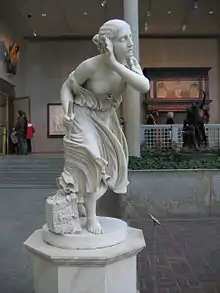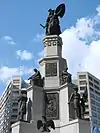
Randolph Rogers (July 6, 1825 in Waterloo, New York – January 15, 1892 in Rome, Italy) was an American Neoclassical sculptor. An expatriate who lived most of his life in Italy, his works ranged from popular subjects to major commissions, including the Columbus Doors at the U.S. Capitol and American Civil War monuments.
Biography

Rogers was born in Waterloo, New York, and his family moved to Ann Arbor, Michigan when he was a child.[1][2]
He developed an interest in wood cuts and wood engraving, and moved to New York City about 1847, but was unsuccessful in finding employment as an engraver. While working as a clerk in a dry-goods store, his employers discovered his native talent as a sculptor and provided funds for him to travel to Italy. He began study in Florence in 1848, where he studied briefly under Lorenzo Bartolini.[3] He then opened a studio in Rome in 1851. He resided in that city until his death in 1892.[4]
He began his career carving statues of children and portrait busts of tourists. He was not happy working with marble consequently all his marble statues were copied in his studio by Italian artisans under his supervision, from an original produced by him in another material. This also enabled him to profit from his popular works. His first large-scale work was Ruth Gleaning (1853), based on a figure in the Old Testament. It proved extremely popular, and up to 20 marble replicas were produced by his studio. His next large-scale work was Nydia, the Blind Flower Girl of Pompeii (1853–54), based on a character in Edward Bulwer-Lytton's best-selling 1834 novel, The Last Days of Pompeii. It proved even more popular, and his studio produced at least 77 marble replicas.[4]
In 1855 he received his first major commission in the United States: great bronze doors for the East Front of the United States Capitol. He chose to depict scenes from the life of Christopher Columbus. The Columbus Doors were modeled in Rome, cast in Munich, and installed in Washington, DC in 1871.[5]
In 1854, Rogers along with William Wetmore Story, Richard Greenough, and Thomas Crawford were each commissioned by Mount Auburn Cemetery to create statues of famous Bostonians to be displayed in the cemetery's chapel.[6] Rogers was commissioned to create a statue of President John Adams.[7] In September 1857, Rogers shipped the completed marble sculpture from Rome, but the ship was lost at sea before its arrival.[8] Rogers was then commissioned to create another copy of his sculpture of "John Adams" and was contracted to create a marble version of Thomas Crawford's plaster sculpture "James Otis" after Crawfords died suddenly.[9] (All of the sculptures were transferred to the Harvard Art Museums in 1935)
Following the 1857 death of sculptor Thomas Crawford, Rogers completed the sculpture program of the Washington Monument at the State Capitol in Richmond.
He designed four major American Civil War monuments: the Soldiers' National Monument (1865–1869) at Gettysburg National Cemetery; the Rhode Island Soldiers' and Sailors' Monument (1866–1871) in Providence; the Michigan Soldiers' and Sailors' Monument (1867–1872) in Detroit; and the Soldiers' Monument (1871–1874) in Worcester, Massachusetts.
He modeled The Genius of Connecticut (1877–1878), a bronze goddess that adorned the dome of the Connecticut State Capitol in Hartford. It was damaged in a 1938 hurricane,[10] removed, and melted down for scrap metal during World War II. A plaster cast of the statue is now exhibited within the building.[4]
In 1873 he became the first American to be elected to Italy's Accademia di San Luca, and he was knighted in 1884 by King Umberto I.[4]
Rogers suffered a stroke in 1882, and was never able to work again.[11] He left his papers and plaster casts of his sculptures to the University of Michigan, where there is also a Nydia replica.[12][13][14][15]
Selected works
List
.jpg.webp)
- Ruth Gleaning (1853), Metropolitan Museum of Art, New York City.[16][17]
- Nydia, the Blind Flower Girl of Pompeii (1853–1854), Metropolitan Museum of Art, New York City.[18]
- John Adams (1854–1859), Memorial Hall, Harvard University, Cambridge, Massachusetts.[19]
- Columbus Doors (1855–1861), East Front, United States Capitol, Washington, D.C.[5]
- Thomas Nelson, Meriwether Lewis, 6 allegorical figures (1857–1858), Washington Monument, Virginia State Capitol, Richmond, Virginia.[20]
- Angel of the Resurrection (1862), Samuel Colt Monument, Cedar Hill Cemetery, Hartford, Connecticut.[21][22]
- Isaac on the Altar (1863–1864), Brooklyn Museum of Art, Brooklyn, New York City [23]
- La Somnambula (1863–1864), Smithsonian American Art Museum, Washington, D.C.[24]
- The Sentinel (1863–1865), Spring Grove Cemetery, Cincinnati, Ohio.[25] One of Ohio's first formal Civil War monuments.[26]
- Soldiers' National Monument (1865–1869), Gettysburg National Cemetery, Gettysburg, Pennsylvania, George Keller, architect.[27]
- Rhode Island Soldiers' and Sailors' Monument (1866–1871), Kennedy Square, Providence, Rhode Island, Alfred Stone, architect.[28]
- Michigan Soldiers' and Sailors' Monument (1867–1872), Detroit, Michigan.[29][30]
- Abraham Lincoln (1870–1871), East Fairmount Park, Philadelphia, Pennsylvania.
- Soldiers' Monument (1871–1874), Worcester, Massachusetts.[31]
- The Lost Pleiade (1874), The Art Institute of Chicago, Chicago, Illinois. Sculpture group of feuding tribes.
- William H. Seward Monument (1875–1876), Madison Square, New York City.[32]
- The Genius of Connecticut (1877–1878), Connecticut State Capitol, Hartford, Connecticut.
- The Last Arrow (statuette) (1879–1880), Metropolitan Museum of Art, New York City.[33]
- The Infant Psyche (bust of the artist's daughter Nora) (c. 1880), Cincinnati Art Museum, Cincinnati, Ohio.
Images
 Ruth Gleaning (1853), Metropolitan Museum of Art, New York City.
Ruth Gleaning (1853), Metropolitan Museum of Art, New York City.%252C_Cedar_Hill_Cemetery%252C_Hartford%252C_CT_-_February_2016.jpg.webp) Angel of the Resurrection (1864) atop Colt Monument, Cedar Hill Cemetery, Hartford, Connecticut.
Angel of the Resurrection (1864) atop Colt Monument, Cedar Hill Cemetery, Hartford, Connecticut. The Sentinel (1864–65), Spring Grove Cemetery, Cincinnati, Ohio.
The Sentinel (1864–65), Spring Grove Cemetery, Cincinnati, Ohio. The Genius of Liberty, Soldiers' National Monument (1865–1869), Gettysburg National Cemetery, Gettysburg, Pennsylvania.
The Genius of Liberty, Soldiers' National Monument (1865–1869), Gettysburg National Cemetery, Gettysburg, Pennsylvania..jpg.webp) Rhode Island Soldiers' and Sailors' Monument (1866–1871), Kennedy Square, Providence, Rhode Island.
Rhode Island Soldiers' and Sailors' Monument (1866–1871), Kennedy Square, Providence, Rhode Island. Michigan Soldiers' and Sailors' Monument (1867–1872), Detroit, Michigan.
Michigan Soldiers' and Sailors' Monument (1867–1872), Detroit, Michigan. Abraham Lincoln (1870–71), East Fairmount Park, Philadelphia, Pennsylvania.
Abraham Lincoln (1870–71), East Fairmount Park, Philadelphia, Pennsylvania. Soldiers' Monument (1871–1874), Worcester, Massachusetts.
Soldiers' Monument (1871–1874), Worcester, Massachusetts. The Lost Pleiad (1873–74), Brooklyn Museum of Art, Brooklyn, New York City.
The Lost Pleiad (1873–74), Brooklyn Museum of Art, Brooklyn, New York City._(cropped).jpg.webp) William H. Seward Monument (1875–76), Madison Square, New York City.
William H. Seward Monument (1875–76), Madison Square, New York City. The Genius of Connecticut (1877–78), Connecticut State Capitol, Hartford, Connecticut. Painted plaster cast, the original bronze statue was damaged and destroyed.
The Genius of Connecticut (1877–78), Connecticut State Capitol, Hartford, Connecticut. Painted plaster cast, the original bronze statue was damaged and destroyed. "Labor" from Soldiers' National Monument
"Labor" from Soldiers' National Monument
Notes
- "Randolph Rogers," Susan James-Gadzinski & Mary Mullen Cunningham, American Sculpture in the Museum of American Art of the Pennsylvania Academy of the Fine Arts (PAFA, 1997), pp. 58–61.
- Millard F. Rogers, Jr. Randolph Rogers: American Sculptor in Rome. University of Massachusetts Press. 1971. ISBN 9780870230875.
- Marc Tarrozzi, Randolph Rogers and the Rhode Island Soldiers' and Sailors' Monument (1989).
- William H. Seward was Secretary of State, 1861–1869.
References
- ↑ "Randolph Rogers' Ann Arbor Life | Ann Arbor District Library". aadl.org. Retrieved 2020-11-30.
- ↑ "Randolph Rogers, The Sculptor | Ann Arbor District Library". aadl.org. Retrieved 2020-11-30.
- ↑ Dizionario degli Artisti Italiani Viventi: pittori, scultori, e Architetti., by Angelo de Gubernatis. Tipe dei Successori Le Monnier, 1889, page 423.
- 1 2 3 4 James-Gadzinski & Cunningham, pp. 58–61.
- 1 2 Columbus Doors from Architect of the Capitol Webpage.
- ↑ "Trustees Records, Vol. 2, 1854". Transcribing Mount Auburn. Mount Auburn Cemetery. p. 85. Retrieved 9 June 2021.
- ↑ De Gubernatis, page 423
- ↑ Bigelow, Jacob (15 January 1858). "Letter from Jacob Bigelow to Louisa W. Crawford". Transcribing Mount Auburn. Mount Auburn Cemetery. p. 2. Retrieved 9 June 2021.
A statue of John Adams by Randolph Rogers, & one of Webster by Powers, are supposed to be lost having been shipped from Leghorn in the Oxford Sept. 1 & not since heard from.
- ↑ Fox, Kathleen (Spring 1996). "The Statues of Bigelow Chapel" (PDF). Sweet Auburn: 3. Retrieved 9 June 2021.
- ↑ Ahles, Dick (2003-09-21). "Remembering the Great Hurricane of '38 (Published 2003)". The New York Times. ISSN 0362-4331. Retrieved 2020-11-30.
- ↑ "More on Randolph Rogers". The Inter Ocean. 1892-01-18. p. 2. Retrieved 2020-11-30.
- ↑ "Heroic Figure of Michigan | Arts & Culture". arts.umich.edu. Retrieved 2020-03-11.
- ↑ "Randolph Rogers | Greek Ann Arbor". Retrieved 2020-03-11.
- ↑ "Exchange: Nydia, the Blind Flower Girl of Pompeii". exchange.umma.umich.edu. Retrieved 2020-03-11.
- ↑ "Moses Rogers House, 1861 | Ann Arbor District Library". aadl.org. Retrieved 2020-11-30.
- ↑ Ruth Gleaning
- ↑ "Bible Gateway passage: Ruth 2 - Common English Bible".
- ↑ Nydia
- ↑ John Adams from Harvard University
- ↑ Virginia Washington Monument
- ↑ Colt Monument
- ↑ Inscription at base of statue shows date as "MDCCCLXIV" (1864).
- ↑ Isaac on the Altar from Brooklyn Museum.
- ↑ La Somnombula
- ↑ The Sentinel
- ↑ Campen, Richard N., Outdoor Sculpture in Ohio: A Comprehensive Overview of Outdoor Sculpture in Ohio, Mid-Nineteenth Century to the Present, West Summit Press, Chagrin Falls, Ohio, 1980.
- ↑ Soldiers' National Monument
- ↑ Rhode Island Monument from Rootsweb.
- ↑ Michigan Monument
- ↑ Carolyn Damstra (Sept. – Oct. 1999). Randolph Rogers Archived 2006-12-20 at the Wayback MachineMichigan History Magazine
- ↑ Worcester Soldiers' Monument
- ↑ Seward Monument
- ↑ The Last Arrow from MMA.